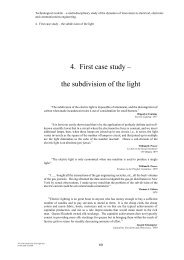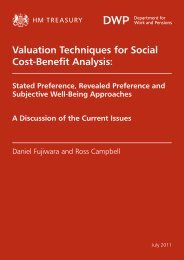Valuing Our Natural Environment Final Report ... - HM Treasury
Valuing Our Natural Environment Final Report ... - HM Treasury
Valuing Our Natural Environment Final Report ... - HM Treasury
You also want an ePaper? Increase the reach of your titles
YUMPU automatically turns print PDFs into web optimized ePapers that Google loves.
<strong>Valuing</strong> <strong>Our</strong> <strong>Natural</strong> <strong>Environment</strong> – <strong>Final</strong> <strong>Report</strong> - Annex1<br />
value is estimated on the basis of the cost of constructing equally effective man-made<br />
defences; an application of the cost of alternatives approach.<br />
A1.1.1.11 Discussion<br />
Market value approaches, as outlined above, typically only provide monetary proxies or<br />
‘benchmarks’ against which the value of the environmental good in question can be judged.<br />
Values that may be derived from these approaches do not represent true valuations as the<br />
assessment only considers whether the environment good is of greater value than the<br />
opportunity cost (Bateman, 1999). Primarily, application of pricing rather than valuation<br />
methods risks the under-valuation of environmental goods. To expand, knowing the price of<br />
a good only informs on the cost of obtaining that good, rather than the actual benefit<br />
derived from the ‘consumption’ of the good. As suggested, the values derived from the<br />
opportunity cost, cost of alternatives, mitigation costs and shadow project costs are a<br />
benchmark set by the market. However, it is important to note that the use of subsidy costs<br />
will typically rely on what may be arbitrary values set by government which do not reflect<br />
opportunity cost.<br />
With regards to opportunity costs, it is likely that the market price of output is likely to<br />
over-estimate the true opportunity cost of an action due distorted market structures which<br />
reflect the political objectives rather than competitive relationships. This may be<br />
particularly true when considering the agricultural sector. Highly intervened markets imply<br />
a certain degree of complexity in the link between market prices and underlying costs,<br />
suggesting that it may be difficult to assess the value of environmental goods in this<br />
manner.<br />
Note also that mitigation costs will typically only provide a partial assessment of the<br />
environmental impact of interest. For instance, the cost of water filtration in order to<br />
improve water quality will only account for the impact that is experienced by water<br />
companies and their customers, and will not account for water pollution damages to<br />
aquatic ecosystems. In relation to the application of shadow project costs, an important<br />
aspect of the procedure would be to demonstrate the adequacy of the shadow project in<br />
terms of replicating the environmental function that is to be lost.<br />
A1.1.1.12 Consideration of distributional impacts<br />
Where markets are distorted, values observed in markets may actually reflect the<br />
preferences of government, who are essentially acting as a single arbiter of valuation,<br />
and/or particular interest groups, rather than the ‘true’ value of the environmental goods<br />
and services to society. This may result in insufficient weighting of values held by a<br />
significant number of individuals not represented by interest groups involved in the political<br />
process.<br />
A1.1.1.13 Advantages and disadvantages<br />
Generally, pricing approaches can be useful in providing an indicative monetary assessment<br />
of the value of environmental goods that might otherwise be regarded as ‘free’. In addition<br />
data may be readily attainable in the form of observable market prices, although some<br />
caution is needed in order to account for price distortions. Strictly though, use of market<br />
values which can inform on the price of obtaining a particular environmental good, does not<br />
inform on the value of the environmental good, and as such it is likely that pricing approach<br />
will lead to under-estimates of the ‘true’ value of environmental goods and services.<br />
A1.1.1.14 Conflicts and synergies with other methods<br />
Some aspects of pricing approaches, such as mitigation costs, may actually serve as inputs<br />
into the production function approach framework (PFA - see separate fiche). Note however,<br />
that in this context, these costs are an input to the analysis in that they are likely to alter<br />
production or cost functions. The PFA enables estimates of changes in consumer and<br />
producer surpluses to be estimated as a result of changes in the provision of environmental<br />
goods and services which are inputs to production processes (e.g. water quality).<br />
eftec A4<br />
December 2006





![AIRTO [Professor Dr Brian Blunden] - HM Treasury](https://img.yumpu.com/15492848/1/184x260/airto-professor-dr-brian-blunden-hm-treasury.jpg?quality=85)










